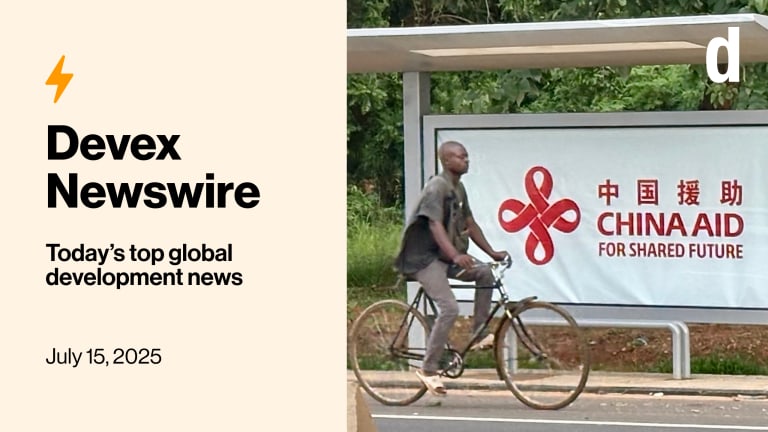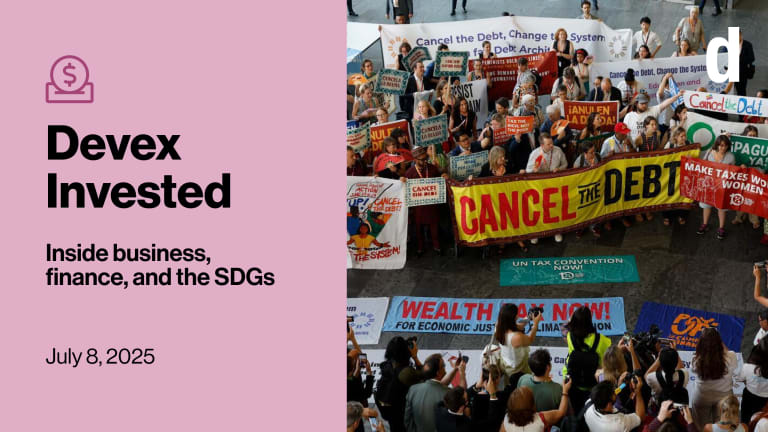What is outcomes-based finance — and where does it go next?
Outcomes-based finance is a growing field. A panel of experts tells Devex how to make the best use of it, and what the latest policy developments are.
Outcomes-based finance is a relatively simple idea with some complex solutions. And it’s growing. Already, according to statistics published recently by the World Economic Forum, outcomes-based finance is valued at $185 billion. According to speakers at a recent Devex panel on the future of OBF in development, it’s an idea that’s destined for further growth. “One of the main drivers over the years has been the SDG funding gap and a recognition that we’re not just going to fill that gap with more money,” said Richard Hawkes, chief executive of the British Asian Trust, an organization which has worked on several outcomes-based finance projects in India and Pakistan. “We’ve got to look at different ways of doing things. And I think more recently, in the last six months or so, I think there’s a much stronger recognition.” What is outcomes-based finance? The principle is straightforward: Organizations deliver a service with a given impact, and get paid for what they achieve. Historically, a government might decide that it wanted to improve educational outcomes, said Anushree Parekh, associate director of social finance at the British Asian Trust. So they would decide to set up a school and pay people to build and operate it. In that situation, all the power — and all the decision making — rests with the organization paying for the work, not the local expert. “In OBF, you turn that on its head,” she said. “So the government or the donor tells you, ‘Hey, I’m interested in improving children’s learning. The implementation partner, the provider, would come in, they would execute interventions that would improve learning. You would measure and verify that learning has happened, and then money exchanges hands.” In many cases, OBF will involve an agreement between several parties. Typically, one party, often a government, will agree to pay out when outcomes are met, such as when a certain number of people find work, or are addiction-free, or have access to sanitation. A number of implementing agencies — often NGOs — will work together, frequently under a lead agency, to deliver the outcomes. And in many cases, there will be a third party — which could be a philanthropy or development finance provider — that provides working capital to deliver the project. That third party would then receive a share in the eventual revenues, typically enough to make a reasonable profit. What are the pros and cons? OBF has long faced criticism because of its complexity and cost. OBF involves several additional costs, including the fees involved in structuring an agreement, the cost of collecting data and carrying out rigorous measurement to assess success, and the need to pay a risk premium to providers who will not receive any funding if the intervention does not work — all of which arguably make outcomes-based projects more expensive than simply giving a grant. Zachary Levey, CEO of Levoca, a forum for organizations working to use OBF to strengthen development, identified three key benefits: trust, accountability, and performance. He said that it increases trust because funders know they will only have to pay out if they get results; that it increases accountability and leads to greater learning because projects must be extremely accurately measured; and that it improves performance and leads to better results because it puts decisions in the hands of experts. Hawkes took particular issue with the idea that OBF is more expensive than other types of funding. He said OBF projects tended to be very effective at ensuring that funding reached local organizations, which tended to be more cost-effective. In a recent project in India, he said, 80% of all funding had gone to local providers. He also said that many traditionally run projects cost less in part because they did not spend enough money evaluating whether they had actually done anything useful. “Of course, there are some fixed costs that there wouldn’t be in other approaches, but that’s because you want to have the rigor of data and evidence and proper evaluation,” he said. “In other approaches, people can take shortcuts and not evaluate things properly, and not collect the data properly. And actually, that becomes far less cost-effective because you don’t know what impact you’re delivering. “To have guaranteed success that’s based on evidence and data, with independent evaluation, and 80% of the funding to go to the local partners on the ground — personally, I think that is brilliantly cost-effective.” When is OBF appropriate? Parekh highlighted three important elements that have to be in place before OBF is the right tool. First, she said, there has to be a consensus on what success looks like. Funders, governments, and providers must agree on the goal they are trying to achieve. Second, that goal must be measurable — there must be a single metric, or a basket of metrics, which can reliably be used to define when that success has been achieved, although Parekh also cautioned against measuring too many things. “I think the temptation to say, ‘Oh, that’s important, let’s measure and pay for it oh, that’s also important, and that’s also important,’ is very high, but we’ve seen that the best outcomes are achieved when there is a sharp focus on two to three outcomes and sort of not spreading it too thin,” she said. And third, there must be a process of risk transfer, whether to the delivery agent or a third party, and that risk transfer must create a benefit that makes the process worthwhile. “Where is the risk lying, and who are we transferring that risk to?” she said. “Because there are certain instruments where the provider is expected to take the risk. And it’s important to ask whether, is that the right way? Does the provider have both the capacity — the capability — and the willingness to take that risk? Or do we need to introduce external investors who can shoulder that risk? And what does underwriting that risk do? Does it give you more flexibility? Does it help you to innovate? Because if there is no additionality in transferring that risk, then maybe you don't go through all of that.” Levey also discussed the importance of stakeholder engagement — and particularly, finding a funder keen to prioritize a particular outcome. Where is OBF taking place? Levey said that OBF is now widespread, with more than 80 countries implementing some kind of project. He picked out countries such as South Africa, Kenya, and Colombia as having made the most progress. Additionally, Hawkes said that there had been a huge level of government support in India and Pakistan, where the British Asian Trust has done much of its work. The sectors where it has been used most often include education and training, but Levey said work was also taking place in areas such as sanitation, biodiversity, and climate. Increasingly, he said, OBF is being used alongside, or as part of, blended finance, where typically outcomes-first funders such as governments, development agencies, nonprofits or philanthropies will take riskier or less profitable investments in a project, or even give grants to create financial conditions that are suitable for more profit-driven investors. Parekh said that increasingly, in India, the British Asian Trust was seeing outcomes-based finance used at a much larger scale. While many of the most successful projects have been in education, panelists also noted similarly successful projects in global health. What are the recent developments? Outcomes-based finance is referenced as a tool for the future in the recent Compromiso de Sevilla, which summarizes the main outcomes from the fourth Financing for Development conference. Numerous new measures were announced at the conference that will take it forward. Levey said he noted “a tipping point” in recent conversations, as donors began to realize that they would have to do more with less money, and that OBF might be a more efficient way forward. “Richard and I were at a high-level roundtable [on OBF] with heads of U.N. agencies, MDBs, a number of ministers,” he said. “And really, it was really interesting to see that this conversation was just part of how they were now thinking about their funding going forward. How did they use their funding more effectively? How did they leverage resources more effectively? How do they engage in nontraditional partnerships with the private sector and the nonprofit sector, and the philanthropic sector? “I think a lot of these different things that are kind of converging really make it from something that's an interesting concept to a necessity,” Levey said. Several new announcements emerged from FfD4 that will push OBF forward in the coming years, Levey said, including a $100 million outcomes fund and an accelerator program to scale up existing OBF programs. However, he said the most powerful new announcement was likely to be a decision by the Organisation for Economic Co-operation and Development to publish a set of guidelines on best practice for OBF. “That’s because a lot of governments — who are, at the end of the day, oftentimes the ones who really have to be driving this process and funding it — really look to the OECD as a technical body to validate, provide support and guidance on this,” he said.
Outcomes-based finance is a relatively simple idea with some complex solutions. And it’s growing. Already, according to statistics published recently by the World Economic Forum, outcomes-based finance is valued at $185 billion.
According to speakers at a recent Devex panel on the future of OBF in development, it’s an idea that’s destined for further growth.
“One of the main drivers over the years has been the SDG funding gap and a recognition that we’re not just going to fill that gap with more money,” said Richard Hawkes, chief executive of the British Asian Trust, an organization which has worked on several outcomes-based finance projects in India and Pakistan. “We’ve got to look at different ways of doing things. And I think more recently, in the last six months or so, I think there’s a much stronger recognition.”
This story is forDevex Promembers
Unlock this story now with a 15-day free trial of Devex Pro.
With a Devex Pro subscription you'll get access to deeper analysis and exclusive insights from our reporters and analysts.
Start my free trialRequest a group subscription Printing articles to share with others is a breach of our terms and conditions and copyright policy. Please use the sharing options on the left side of the article. Devex Pro members may share up to 10 articles per month using the Pro share tool ( ).
David Ainsworth is business editor at Devex, where he writes about finance and funding issues for development institutions. He was previously a senior writer and editor for magazines specializing in nonprofits in the U.K. and worked as a policy and communications specialist in the nonprofit sector for a number of years. His team specializes in understanding reports and data and what it teaches us about how development functions.








